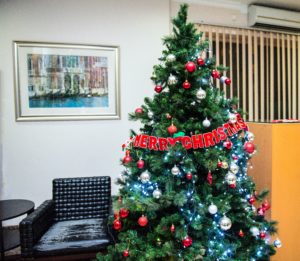By: Cassandra Brandt
For many Americans, the holidays are a busy and exciting time full of festivities. People living in assisted living homes and skilled nursing facilities can feel excluded from the holiday fun unless management makes the season a merry time.
The holidays used to be the time of year when I’d rush home to my parent’s house for a couple memorable days around the Christmas tree before going back out on the road. I was a traveling tradeswoman and prided myself in picking out the best gifts and always making it home by Christmas Eve.
After my spinal cord injury, everything changed.
Instead of decorating my own home and serving my guests, I’m living in a group setting and have little control over the festivities.
Assisted Living Life
The National Center for Assisted Living defines assisted living communities as those that serve people who need help with Activities of Daily Living but who don’t need 24-hour skilled nursing care. A growing number of senior citizens and people with disabilities like spinal cord injuries live in this setting today in the US.
Typically these communities claim to offer independence, privacy and security in a homelike setting with care personalized to meet the needs and preferences of each resident.
The differences between the first two group homes in which I resided after my spinal cord injury were striking. At the first place, a home with nine residents and two live-in caregivers, the caregivers were over-worked and often short-tempered. Minimal efforts were made by management to evoke the feeling of home for the residents.
A good assisted living home will provide a homelike atmosphere and engage residents to make the holidays feel special, but unfortunately some don’t make this effort.
At the first assisted living home, the only event distinguishing Christmas from any other day was the manager bought food from the deli. They put up one mini tree in a corner a couple weeks before Christmas. The TV wasn’t working in the living room so they didn’t even play Christmas music. I was able to leave and spend the day at my parent’s house, but other residents didn’t have anywhere to go.
I moved into a new assisted living home just in time for the holidays the following year.
A Merry Christmas Community
At the new home, the whole house was decorated and smelled like cookies for weeks. A beautiful tree graced the living room, garland was strung down the halls, soft carols played in the kitchen and Christmas movies played on TV. Caregivers brought in home-cooked dishes and made delicious food, and management bought each resident an inexpensive but unique and thoughtful gift.
On Christmas Day my family came over for several hours and we had the living room to ourselves. The elderly people were mostly napping after the community meal, during which we had opened our presents and filled our bellies around the dining room table; afterward I was able to enjoy my family and felt absolutely like I was at home.
Later that evening a couple residents joined me near the tree to watch a Christmas movie before bed. While getting me into bed my night caregivers told me about their Christmas and I told them about mine. All three of us were munching on shortbread cookies with Christmas sprinkles.
It really was a beautiful Christmas.
Sometimes the demands of spinal cord injury are too overwhelming on a family or a budget, and assisted living is the option.
Finding an assisted living home that focuses on quality of life makes a big difference for people with disabilities.
This domestic arrangement isn’t always ideal; a home that doesn’t try to make residents feel like it’s their home can really take the spirit out of Christmas. It’s hard enough being separated from our families and the comfort of our homes. A good home, by contrast, can offer great benefits, like opportunity for community, and beautiful bonds formed among caregivers and residents.



